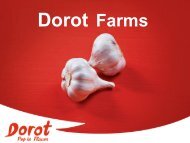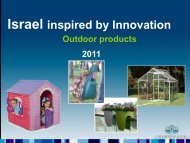PDF file - Israel Trade Commission
PDF file - Israel Trade Commission
PDF file - Israel Trade Commission
Create successful ePaper yourself
Turn your PDF publications into a flip-book with our unique Google optimized e-Paper software.
Agriculture 2011<br />
Fig. 3. A hook lift container with a rolling bottom conveyor loaded<br />
with onions.<br />
damage to the onion. The main conclusion was that the<br />
imported machinery is not suitable for <strong>Israel</strong>i harvesting<br />
conditions and there is a need to develop local onion<br />
harvesting machinery. The <strong>Israel</strong>i onions are grown on<br />
beds and harvested in two ways: 1. harvesting fresh<br />
onions; 2. harvesting dry onions. The fresh onions are<br />
harvested at the beginning of the season in two stages.<br />
After cutting the foliage, workers dig the onions by hand<br />
and put them on the ground for curing. About 3 days after<br />
they are collected, the onions are placed in boxes and<br />
sent to the local markets. The dry onions are collected<br />
directly from the ground, placed into boxes and sent to<br />
the markets.<br />
Development of harvesting machinery<br />
According to the knowledge gained from the test results<br />
of the imported machinery and the study of the <strong>Israel</strong>i<br />
onion growth and harvesting conditions, a prototype<br />
digger and a harvester were designed and constructed.<br />
The digger (fig. 1) has a square and round bar digging<br />
system, a round bar conveyor mounted on the machine<br />
with two inclinations (15 degrees forward and 25 degrees<br />
backwards), above the front of the conveyor there is a<br />
rotor with 4 rubber wings, a digging depth automatic<br />
controller and a speed monitor to help the operator to<br />
adjust the conveyor speed to the tractor speed. The two<br />
inclines were designed to prevent onions from rolling at<br />
the front of the digger and to put them on the ground from<br />
behind at a low level. The rotor rubber wings help the<br />
onions climb onto the conveyor. The digger is operated<br />
by an 80hp field tractor using the 3 point linkage.<br />
The harvester (fig. 2) was designed for harvesting fresh<br />
and dry onions. Therefore, it has the same digging<br />
system as that of the digger. The harvester has two<br />
conveyors. The first one is a round bar conveyor mounted<br />
at a 15 degree slope in order to prevent back rolling of<br />
the onions. Above the front of the conveyor there is a<br />
rotor with 4 rubber wings to help the onions climb onto<br />
it. The second conveyor is a loading conveyor with 3<br />
segments for loading different height containers and for<br />
folding them during road driving. The loading conveyor<br />
is mounted perpendicular behind the first conveyor. The<br />
top end of the conveyor can be adjusted during work<br />
to the height level of the container bottom in order to<br />
prevent mechanical damages. The harvester has an<br />
automatic depth control system, a conveyor speed<br />
measuring 8 and adjusting system and a width balance<br />
controller to keep the harvester parallel to the ground.<br />
The harvester is drawn by an 80hp tractor on two<br />
wheels with an automatic return steering system. The<br />
harvester has a self hydraulic system for operating the<br />
conveyors and other components. The driver controls<br />
the harvester systems from the tractor cabin by an<br />
electronic controller.<br />
The digger was constructed by “Agromond Ltd.” and<br />
the harvester was constructed by “Juran Ltd.”. To date 3<br />
diggers and 1 harvester have been constructed and are<br />
being operated by 4 <strong>Israel</strong>i onion growers.<br />
Farmers that have onion packing houses collect and<br />
transport the onions in large hook lift containers. In<br />
the packing house the container is lifted and unloaded<br />
into a big hoper. This method of unloading causes the<br />
onions to fall and roll into the hoper from a high level,<br />
get damaged and lose their peels. In order to prevent<br />
unloading damages, a container with a bottom rolling<br />
conveyor was designed and constructed in cooperation<br />
with “Green Arava Valley”, “Ardom Growth” and The Ilan<br />
Haruvi Workshop (fig. 3).<br />
There is no need to lift the container for unloading in<br />
the packing house. The driver puts the back door of the<br />
container above the hoper, opens the back door and<br />
connects the electrical motor to the rolling conveyor<br />
axle. From this moment the conveyors are rolled under<br />
control, the onions fall into the hoper from a low level<br />
and are not rolled. The system has been operated by<br />
“Kibbutz Yotvata” and “Ardom Growth” for the past 2<br />
years. They reported that the amount of marketed onions<br />
has increased by 6% due to the reduction in mechanical<br />
damages.<br />
isagi@agri.gov.il<br />
7
















